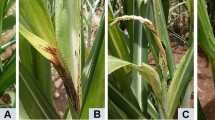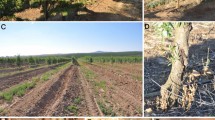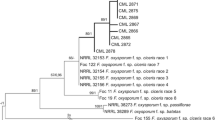Abstract
During 2019, severe symptoms of crown, basal stem and root rot associated with vascular discoloration were observed on Dipladenia and Grevillea ornamental species in a nursery located in Southern Italy. Fusarium spp. colonies were consistently recovered from infected tissues on semi-selective media. Molecular and phylogenetic analyses of the internal transcribed spacer (ITS) of rDNA, RNA polymerase second largest subunit (RPB2) and elongation factor 1-alpha (tef1-α) regions allowed to identify F. nirenbergiae and F. elaeidis as causal agents of infections from Dipladenia Sundaville® and Grevillea gracilis, respectively. The pathogenicity of both fungi was confirmed on young pot-grown cuttings of two ornamental plants, where they reproduced symptoms very similar to those observed in the nursery. Re-isolation of fungi from symptomatic tissues definitively confirmed aetiology of infections. In addition, among tested Dipladenia cultivars, “Classic Red” showed the significant highest percentage of disease incidence (almost 40% of plants) one month post inoculation. Similarly, disease occurrence recorded on young cuttings G. gracilis reached the maximum level 20 days after inoculation, interesting 100% of plants. This study reports the occurrence of Fusarium nirenbergiae and F. elaeidis causing diseases on Dipladenia and Grevillea plants.








Similar content being viewed by others
References
Aiello, D., Guarnaccia, V., Vitale, A., Cirvilleri, G., Granata, G., Epifani, F., Perrone, G., Polizzi, G., Groenewald, J. Z., & Crous, P. W. (2014). Ilyonectria palmarum sp. nov. causing dry basal stem rot of Arecaceae. European Journal of Plant Pathology, 138, 347–359.
Aiello, D., Guarnaccia, V., Formica, P. T., Hyachumachi, M., & Polizzi, G. (2017a). Occurrence and characterisation of Rhizoctonia species causing diseases of ornamental plants in Italy. European Journal of Plant Pathology, 148, 967–982.
Aiello, D., Polizzi, G., Crous, P. W., & Lombard, L. (2017b). Pleiocarpon gen. nov. and a new species of Ilyonectria causing basal rot of Strelitzia reginae in Italy. IMA Fungus, 8, 65–76.
Aiello, D., Hansen, Z., Smart, C., Polizzi, G., & Guarnaccia, V. (2018a). Characterisation and mefenoxam sensitivity of Phytophthora spp. from ornamental plants in Italian nurseries. Phytopathologia Mediterranea, 57, 245–256.
Aiello, D., Polizzi, G., & Guarnaccia, V. (2018b). First report of crown, root and stem rot caused by binucleate Rhizoctonia AG-R on Mandevilla sanderi hybrid in Italy. Plant Disease, 102, 1658.
Aiello, D., Fiorenza, A., Leonardi, G. R., Vitale, A., & Polizzi, G. (2021). Fusarium nirenbergiae (Fusarium oxysporum species complex) causing the wilting of passion fruit in Italy. Plants, 10(10), 2011.
Baayen, R. P., & Rijkenberg, F. H. J. (1999). Fine structure of the early interaction of lily roots with Fusarium oxysporum f. sp. lilii. European Journal of Plant Pathology, 105, 431–443.
Baayen, R. P., O’Donnell, K., Bonants, P. J. M., Cigelnik, E., Kroon, L. P., Roebroeck, E. J., & Waalwijk, C. (2000). Gene genealogies and AFLP analyses in the Fusarium oxysporum complex identify monophyletic and non-monophyletic formae speciales causing wilt and rot diseases. Phytopathology, 90, 891–900.
Carbone, I., & Kohn, L. M. (1999). A method for designing primer sets for speciation studies in filamentous ascomycetes. Mycologia, 91, 553–556.
Crous, P., Lombard, L., Sandoval-Denis,M., Seifert, K., Schroers, H.J., Chaverri, P., Gené, J., Guarro, J., Hirooka, Y., Bensch, K.; et al. (2021). Fusarium: More than a node or a foot-shaped basal cell. Studies in Mycology, 98, 100116.
Dean, R., Van Kan, J. A., Pretorius, Z. A., Hammond-Kosack, K. E., Di Pietro, A., Spanu, P. D., Rudd, J. J., Dickman, M., Kahmann, R., Ellis, J., & Foster, G. D. (2012). The top 10 fungal pathogens in molecular plant pathology. Molecular Plant Pathology, 13, 414–430.
Edel-Hermann, V., & Lecomte, C. (2019). Current status of Fusarium oxysporum Formae Speciales and races. Phytopathology, 109, 512–530. https://doi.org/10.1094/PHYTO-08-18-0320-RVW
European Commission - Civil Dialogue Group (2015). Horticultural Products, Plants.
Flood, J. (2006). A review of Fusarium wilt of oil palm caused by Fusarium oxysporum f. sp. elaeidis. Phytopathology, 96, 660–662.
Guarnaccia, V., Aiello, D., Polizzi, G., Crous, P. W., & Sandoval-Denis, M. (2019). Soilborne diseases caused by Fusarium and Neocosmospora spp. on ornamental plants in Italy. Phytopathologia Mediterranea, 58, 127–137.
Guarnaccia, V., Peduto-Hand, F., Garibaldi, A., & Gullino, M. L. (2021). Bedding plant production and the challenge of fungal diseases. Plant Disease. https://doi.org/10.1094/PDIS-09-20-1955-FE
Gullino, M. L., Daughtrey, M. L., Garibaldi, A., & Elmer, W. H. (2015). Fusarium wilts of ornamental crops and their management. Crop Protection, 73, 50–59.
Hillis, D. M., & Bull, J. J. (1993). An empirical test of bootstrapping as a method for assessing confidence in phylogenetic analysis. Systematic Biology, 42, 182–192.
Jarvis, W. R., & Shoemaker, R. A. (1978). Taxonomic status of Fusarium oxysporum causing foot and root rot of tomato. Phytopathology, 68, 1679–1680.
Kumar, S., Stecher, G., Li, M., Knyaz, C., & Tamura, K. (2018). MEGA X: Molecular evolutionary genetics analysis across computing platforms. Molecular Biology and Evolution, 35, 1547–1549. https://doi.org/10.1093/molbev/msy096
Liu, Y. J., Whelen, S., & Hall, B. D. (1999). Phylogenetic relationships among ascomycetes: Evidence from an RNA polymerse II subunit. Molecular Biology and Evolution, 16, 1799–1808.
Lombard, L., Sandoval-Denis, M., Lamprecht, S. C., & Crous, P. W. (2019). Epitypification of Fusarium oxysporum - clearing the taxonomic chaos. Persoonia, 43, 1–47.
Lupien, S. L., Dugan, F. M., Ward, K. M., & O’Donnell, K. (2017). Wilt, crown, and root rot of common rose mallow (Hibiscus moscheutos) caused by a novel Fusarium sp. Plant Disease, 101, 354–358.
Miller, M. A., Pfeiffer, W., & Schwartz, T. (2012). The CIPRES science gateway: Enabling high-impact science for phylogenetics researchers with limited resources. In Proceedings of the 1st conference of the extreme science and engineering discovery environment: Bridging from the extreme to the campus and beyond (pp. 1–8). Association for Computing Machinery.
O’Donnell, K., Rooney, A. P., Proctor, R. H., Brown, D. W., McCormick, S. P., Ward, T. J., Frandsen, J. N., Lysøe, E., Rehner, S. A., Aoki, T., Robert, V. A. R. G., Crous, P. W., Groenewald, J. Z., Kang, S., & Geiser, D. M. (2013). Phylogenetic analyses of RPB1 and RPB2 support a middle cretaceous origin for a clade comprising all agriculturally and medically important fusaria. Fungal Genetics and Biology, 52, 20–31. https://doi.org/10.1016/j.fgb.2012.12.004
O’Donnell, K., Ward, T. J., Robert, V. A. R. G., Crous, P. W., Geiser, D. M., & Kang, S. (2015). DNA sequence-based identification of Fusarium: Current status and future directions. Phytoparasitica, 43, 583–595. https://doi.org/10.1007/s12600-015-0484-z
Olivain, C., & Alabouvette, C. (1999). Process of tomato root colonization by a pathogenic strain of Fusarium oxysporum f. sp. lycopersici in comparison with a non-pathogenic strain. New Phytologist, 141, 497–510.
Polizzi, G., Vitale, A., Aiello, D., & Parlavecchio, G. (2006). First record of crown and root rot caused by Cylindrocladium pauciramosum on California lilac in Italy. Plant Disease, 90, 1459.
Polizzi, G., Vitale, A., Aiello, D., Dimartino, M. A., & Parlavecchio, G. (2007). First report of damping-off and leaf spot caused by Cylindrocladium scoparium on different accessions of bottlebrush cuttings in Italy. Plant Disease, 91, 769.
Polizzi, G., Aiello, D., Guarnaccia, V., Vitale, A., Perrone, G., & Epifani, F. (2010a). First report of Fusarium wilt on Eremophila spp. caused by Fusarium oxysporum in Italy. Plant Disease, 94, 1509.
Polizzi, G., Aiello, D., Guarnaccia, V., Vitale, A., Perrone, G., & Stea, G. (2010b). First report of Fusarium wilt of paper flower (Bougainvillea glabra) caused by Fusarium oxysporum in Italy. Plant Disease, 94, 483.
Polizzi, G., Aiello, D., Guarnaccia, V., Vitale, A., Perrone, G., & Stea, G. (2011). First report of Fusarium wilt on Philotheca myoporoides caused by Fusarium oxysporum in Italy. Plant Disease, 95, 877.
Polizzi, G., Vitale, A., Aiello, D., Guarnaccia, V., Crous, P. W., & Lombard, L. (2012). First report of Calonectria ilicicola causing a new disease on Laurus (Laurus nobilis). Journal of Phytopathology, 160, 41–44.
Sella, L., Cosmi, T., Giacomello, F., Saccardi, A., & Favaron, F. (2010). First report of Fusarium oxysporum on Dipladenia sp. in Italy. Journal of Plant Pathology, 92, 543.
Shah, D. A., & Madden, L. V. (2004). Nonparametric analysis of ordinal data in designed factorial experiments. Phytopathology, 94, 33–43.
Stamatakis, A. (2014). RAxML version 8: A tool for phylogenetic analysis and post-analysis of large phylogenies. Bioinformatics, 30, 1312–1313. https://doi.org/10.1093/bioinformatics/btu033
Swofford, D. L. (2003). PAUP*. Phylogenetic analysis using parsimony (* and other methods). Version 4. Sinauer Associates. https://doi.org/10.1111/j.0014-3820.2002.tb00191.x
Vitale, A., & Polizzi, G. (2008). First record of leaf spots and stem lesions on Pistacia lentiscus caused by Cylindrocladium pauciramosum and C. scoparium in Italy. Plant Disease, 57, 384.
Vitale, A., Aiello, D., Castello, I., Dimartino, M. A., Parlavecchio, G., & Polizzi, G. (2009). Severe outbreak of crown rot and root rot caused by Cylindrocladium pauciramosum on strawberry tree in Italy. Plant Disease, 93, 842.
Vitale, A., Crous, P. W., Lombard, L., & Polizzi, G. (2013). Calonectria diseases on ornamental plants in Europe and the Mediterranean basin: An overview. Journal of Plant Pathology, 95, 463–476.
White, T. J., Bruns, T., Lee, S., & Taylor, J. (1990). Amplification and direct sequencing of fungal ribosomal RNA genes for phylogenetics. PCR Protocols: A Guide to Methods and Applications, 18, 315–321.
Funding
Authors wish to acknowledge the grants which supported this work: Programma Ricerca di Ateneo UNICT 2020–2022 linea 2 - University of Catania (Italy); Starting Grant 2020, University of Catania (Italy); Fondi di Ateneo 2020–2022, University of Catania (Italy), linea Open Access. Research Project 2016–2018, University of Catania 5A722192134.
Author information
Authors and Affiliations
Corresponding author
Ethics declarations
Conflicts of interest/competing interests
The authors declare that no conflicts of interest exist.
Ethics approval
The authors declare that ethical standards have been followed and that no human participants or animals were involved in this research.
Consent to participate
Not applicable.
Consent for publication
Consent for publication was obtained from all co-authors.
Rights and permissions
About this article
Cite this article
Aiello, D., Gusella, G., Vitale, A. et al. Characterization of Fusarium nirenbergiae and F. elaeidis causing diseases on Dipladenia and Grevillea plants. Eur J Plant Pathol 162, 885–896 (2022). https://doi.org/10.1007/s10658-021-02444-z
Accepted:
Published:
Issue Date:
DOI: https://doi.org/10.1007/s10658-021-02444-z




